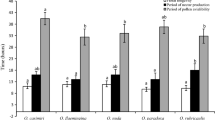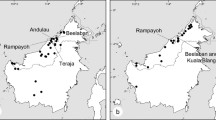Abstract
Establishment of polyploid individuals within diploid populations is theoretically unlikely unless polyploids are reproductively isolated, pre-zygotically, through assortative pollination. Here, we quantify the contribution of pollinator diversity and foraging behaviour to assortative pollen deposition in three mixed-ploidy populations of Chamerion angustifolium (Onagraceae). Diploids and tetraploids were not differentiated with respect to composition of insect visitors. However, foraging patterns of the three most common insect visitors (all bees) reinforced assortative pollination. Bees visited tetraploids disproportionately often and exhibited higher constancy on tetraploids in all three populations. In total, 73% of all bee flights were between flowers of the same ploidy (2x–2x, 4x–4x); 58% of all flights to diploids and 83% to tetraploids originated from diploid and tetraploid plants, respectively. Patterns of pollen deposition on stigmas mirrored pollinator foraging behaviour; 73% of all pollen on stigmas (70 and 75% of pollen on diploid and tetraploid stigmas, respectively) came from within-ploidy pollinations. These results indicate that pollinators contribute to high rates of pre-zygotic reproductive isolation. If patterns of fertilization track pollen deposition, pollinator–plant interactions may help explain the persistence and spread of tetraploids in mixed-ploidy populations.




Similar content being viewed by others
References
Burton TL, Husband BC (2000) Fitness differences among diploids, tetraploids and their triploid hybrids in Chamerion angustifolium (Onagraceae): mechanisms of inviability and implications for polyploid evolution. Evolution 54:1182–1191
Coyne JA, Orr HA (1989) Two rules of speciation. In: Otte D, Endler J (eds) Speciation and its consequences. Sinauer Associates, Sunderland
Coyne JA, Orr HA (1998) The evolutionary genetics of speciation. Philos Trans R Soc Lond B Biol Sci 353:287–305
Dart S, Kron P, Mable BK (2004) Characterizing polyploidy in Arabidopsis lyrata using chromosome counts and flow cytometry. Can J Bot 82:185–197
Felber F (1991) Establishment of a tetraploid cytotype in diploid populations: effect of relative fitness of the cytotypes. J Evol Biol 4:195–207
Galen C, Plowright C (1985) Contrasting movement patterns of nectar-collecting and pollen-collecting bumble bees (Bombus terricola) on fireweed (Chamerion angustifolium) inflorescences. Ecol Entomol 10:9–17
Grant V (1992) Floral isolation between ornithophilous and sphingophilous species of Ipomopsis and Aquilegia. Proc Natl Acad Sci USA 89:11828–11831
Grant V (1994) Modes and origins of mechanical and ethological isolation in angiosperms. Proc Natl Acad Sci USA 91:3–10
Husband BC (2000) Contraints on polyploid evolution: a test of the minority cytotype exclusion principle. Proc R Soc Lond B Biol Sci 267:1–7
Husband BC (2004) Polyploidy and plant adaptation: a framework for future research. In: Cronk QCB, Whitton J, Ree RH, Taylor IEP (eds) Plant adaptation: molecular genetics and ecology. In: Proceedings of an international workshop held December 11–13, 2002, in Vancouver, BC, Canada. NRC Research Press, Ottawa, pp 119–126
Husband BC, Schemske DW (1997) Effects of inbreeding in diploid and tetraploid populations of Epilobium angustifolium: implications for the genetic basis of inbreeding depression. Evolution 51:737–746
Husband BC, Schemske DW (1997) Cytotype distribution at a diploid–tetraploid contact zone in Chamerion (Epilobium) augustifolium (Onagraceae). Am J Bot 85:1688–1694
Husband BC, Schemske DW (2000) Ecological mechanisms of reproductive isolation between diploid and tetraploid Chamerion angustifolium. J Ecol 88:689–701
Husband BC, Sabara HA (2004) Reproductive isolation between autotetraploids and their diploid progenitors in fireweed, Chamerion angustifolium. New Phytologist 161:703–713
Husband BC, Schemske DW, Goodwillie C, Burton TL (2002) Pollen competition as a unilateral mechanism of reproductive isolation between diploid and tetraploid Chamerion angustifolium. Proc R Soc Lond 269:2565–2571
Johnston M (1991) Natural selection on floral traits in two species of Lobelia cardinalis and siphilitica. Evolution 45:1468–1479
Jones CE (1978) Pollinator constancy as a pre-pollination isolation mechanism between sympatric species of Cercidium. Evolution 32:189–198
Levin DA (1975) Minority cytotype exclusion in local plant populations. Taxon 24:35–43
Mayr E (1942) Systematics and the origin of species. Columbia University Press, Cambridge
Mosquin E (1966) A new taxonomy for Epilobium angustifolium L. (Onagraceae) Brittonia 18:167–188
Nuismer SL, Cunningham BM (2005) Selection for phenotypic divergence between diploid and autotetraploid Heuchera grossulariifolia. Evolution 59:1928–1935
Otto SP, Whitton J (2000) Polyploid incidence and evolution. Ann Rev Genet 34:401–437
Ramsey J, Schemske DW (1998) Pathways, mechanisms and rates of polyploid formation in flowering plants. Annu Rev Ecol Syst 29:4676–4501
SAS Institute (2002) JMP—the statistical discovery software, version 5.0. SAS Institute, Carey
Schemske DW, Bradshaw HD Jr (1999) Pollinator preference and the evolution of floral traits in monkeyflowers (Mimulus). Proc Natl Acad Sci USA 96:11910–11915
Segraves KA, Thompson JN (1999) Plant polyploidy and pollination: floral traits and insect visits to diploid and autotetraploid Heuchera grossiulariifolia. Evolution 53:1114–1127
Sokal RR, Rohlf FJ (1995) Biometry: the principles and practice of statistics in biological research, 3rd edn. WH Freeman and Co., New York
Spiegelhalter D, Thomas A, Best N, Lunn D (2003) WinBugs user manual. http://www.mrc-bsu.cam.ac.uk/bugs/welcome.shtml
Thompson JD, Lumaret R (1992) The evolutionary dynamics of polyploid plants: origins, establishment and persistence. Trends Ecol Evol 7:302–307
Waser NM (1986) Flower constancy: definition, cause and measurement. Am Nat 127:593–603
Acknowledgments
We thank Jeff Warner for his assistance in the field, Ralph Cartar for help identifying pollinators and Elizabeth Elle for comments on the manuscript. This work was supported by an Alberta Conservation Association Grant in Biodiversity to HS and an NSERC Discovery Grant, Premier’s Research Excellence Award and a Canada Research Chair Award to BCH. All research complied with the current regulations of landowners and the Canadian Government.
Author information
Authors and Affiliations
Corresponding author
Additional information
Communicated by Jacqui Shykoff.
Rights and permissions
About this article
Cite this article
Kennedy, B.F., Sabara, H.A., Haydon, D. et al. Pollinator-mediated assortative mating in mixed ploidy populations of Chamerion angustifolium (Onagraceae). Oecologia 150, 398–408 (2006). https://doi.org/10.1007/s00442-006-0536-7
Received:
Accepted:
Published:
Issue Date:
DOI: https://doi.org/10.1007/s00442-006-0536-7




